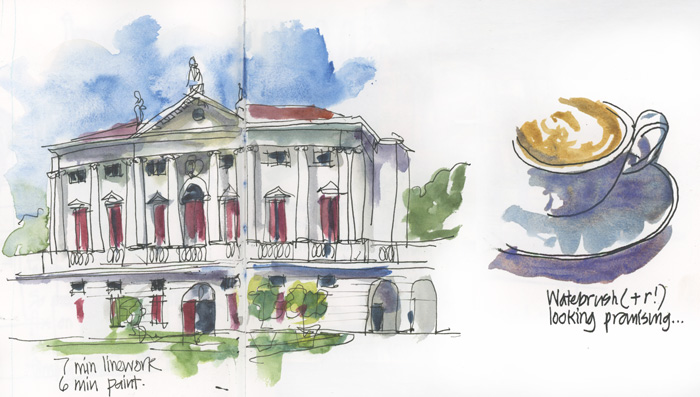
There is no doubt that using a waterbrush when out urban sketching is super convenient. But on the other hand, it doesn’t create beautiful vibrant granulating washes the way that a real brush does.
One of the items on my ‘to develop further’ list is to find out a way to produce a result that I am happy with using a waterbrush. So a few weeks ago I did a few tests. You might have seen these in the article on ‘Nightly Sketches’ but I thought it was worth sharing a few closer versions of the images.
These two sketches – one of the magnificent Ca’ Marcello (on the Palladian Odyssey itinerary!) and the other of my morning coffee – were done using a waterbrush. At the time I was relatively happy with the result, and in two areas particularly:
- the sky where I pre-wet the page and dropped in colour
- the coffee cup where I used a very watery wash with some highly granulating pigment

However, when I compared with a similar application of watercolour using a real brush (this was my sable blend dagger) the results looked flat.

Ah! herein lies the issue for me: no matter how good a result I think I am getting with a waterbrush, I always know that I could get a better one with a real brush.
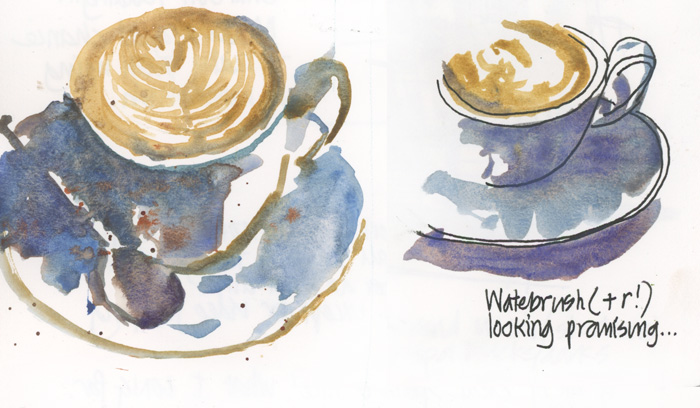
I would love to be proven wrong!
So please share your waterbrush tricks with me. What am I missing?




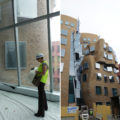
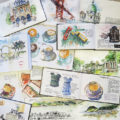
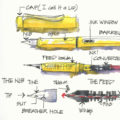
29 Comments
I have used waterbrushes exclusively since Feb 2016 – the convience won me over, plus the price and how well the acrylic brushes keep their tip. I now use three – one big flat that you can take the adapter off and use as a big, loose wash and splatter brush, a medium flat for smaller loose drawings and the pentel medium round for detail. With Daniel Smith colours I never feel a lack of vibrance and there aren’t any techniques I haven’t been able to adapt. It was a learning curve starting out, you do have to work differently, but after a month of forcing mysel to use only waterbrushes I never got my Rosemary and co sables out again!
thanks for sharing Shelley – so you don’t find the difference between the two that I have here?
Shelley, I’m intrigued by your success with waterbrushes. Can you please tell me what you mean by taking the adapter off the flat brush? Also, can you share the brand of your flat brushes. I have lots of rounds that I like, but haven’t tried the flats. Maybe THEY are the magic bullet? 🙂 Thanks.
Niji makes a 1/2″ flat and Derwent makes a 1/4″ flat.
You can remove the Kuretake Flat Head’s by removing the tip that flatens the brush – https://www.jetpens.com/Kuretake-Water-Brush-2-Way-Flat-Head/pd/2681
Yes, that’s exactly it!
I share Liz’s reservations about waterbrushes, but have lately been given a tip similar to Liz’s, that I haven’t tried yet. It relates to the flow of water through different makes of waterbrush. The gentleman uses a large Pentel (I think) as a water only brush. Then uses Kuratake brushes, which require squeezing to get water to flow, to pick up fairly dry colour which you can drop or brush on to damp or wet paper. He reckons he gets really deep darks and satisfying blends.
Thanks, everyone! I’m anxious to try these. Like Shelley, I really want to learn to use a waterbrush, because of the convenience, but like Liz, I really don’t like their mark making nearly as much as a “real” brush. I’ll take your advice, Shelley, and give it some concentrated and exclusive time.
I have recently been having problems with waterbrushes – they clog (no matter how well I clean them), and therefore do not last long. Yes, waterbrushes have been convenient since I do not need to even carry bottles of water – I just dab off pigments with tissue paper. I have since gone back to traditional sable brushes as default, and have bought the Schmincke watercolor palette with water reservoir and water basin set. I have also began appreciating nylon brushes for their stiffer hairs for a more color intense application onto paper and easier for me to draw out the shapes I need.
thanks for sharing Janeil. I love using full sable in the studio. but for out on location I love a sable blend as it is the best of both worlds
I’ve never heard of this particular Schminke palette with water reservoir and basin. Would you please post a link to it? Thanks!
Hi Janeil,
I’ve never heard of this Schmincke watercolor palette with water reservoir and water basin set. Would you please post a link to it? Thank you!
https://www.amazon.com/SCHMINCKE-Schmincke-Horadam-Color-74408097/dp/B000WCYE1W
I recently used waterbrushes while sketching live performances and I also agree that nothing can replace an actual brush. However, in venues where it would be awkward to have an open container of water , and for fast sketching under these circumstances, the waterbrushes are awesome!! The sketches are for my own use and memory recording, so I don’t set out with the intention of producing gallery quality works. So waterbrushes will definitely remain in my travelling kit.
I have a Rosemary & co sable travel brush that releases too much water when it touches the paper, which is the same reaction the water brush has. Not my favorites. Do love the Rosemary dagger blend. Would like suggestions on other brands of sables that hold water longer (release slower) and not release at first touch, reguardless of how light one touches the paper.
You might try a squirrel hair brush (round or quil) if you’re looking for a natural hair. They hold a lot of liquid but the release is more controlled to the touch.
I have also been disappointed with the waterbrush for watercolor washes. It behaves more like a marking pen with hard edges and no gradation. I use mine to soften line madw with an aquarelle graphite pencil.
For me it’s about water flow and brush tips.
One of the key tenants of watercolour is “when two unequal bodies of moisture meet, the greater will always flow into the lesser”. A waterbrush tends to always be the greater flowing into the lesser that has already been painted onto the paper, which is why you see more wet into wet blending results (like on your teacup above), so a real awareness of how wet the paper is is important when you want to mingle colours. Regular brushes make this easier because you don’t pick up more water, just pigment, then the wet paint on the paper is the greater moisture and will hold the heavier pigment.
With regular brushes you can get a larger variety of mark making from belly to tip (quill, dagger etc.) whereas with waterbrushes I find that each brush from belly to tip gives one mark, again because of the constant flow of water. This is why it’s better to work with a variety of tips in hand: a flat, a medium to large round and a very fine round to compensate for this.
I agree about water flow, that’s why I use a variety of different brands as well as different brush shapes. Pentel waterbrushes are my overall favourite because I find I can “starve” the brush a bit and get dry brush techniques to work as well. I like a drier style of waterbrush, rather than a constant flow, I want to be in charge of water flow. It takes practice.
I don’t think you’re missing anything, Liz. Waterbrushes may work for some styles but one thing you just can’t get around is that you can’t dry the brush. I like to be able to lift pigment, shove it around, etc. without having the brush dump more water into the mix. I’ve never found a waterbrush that will allow that.
thanks for all the great conversations everyone!!!!
I used to look down on water brushes, but since I stared using one with my fountain pen sketches in my handbag (purse?USA) sketchbook i’ve become hooked. I mostly used Kuretake and Pentel ones. Personally I find the Pentel one are much wetter and less controllable, but I like that for loose work. The Kuetake ones have a smaller hole for the water to come down to the bristles and so you can control the flow more so I find them more controllable for small or tighter work.
I try and use them in the same way I would use a standard brush and water pot. Wet into wet, wet against dry and so on and have some good results, but when I get home nothing can beat my Rosemary and Co. Roger Jones brush, and of course the famous dagger brush
Thank you so much for helping me with an aha moment!!!! As I commented above, I like the slower flow and control of the pentel water brushes versus kuretake – your comment helped me discover part of the reason that it took time to adapt!!! NEW Pentel water brushes have a rapid flow of water that is hard to control, but as you use them over several months they start to “clog” up and that is when I like them, when you have to give them a good squeeze to get a damp brush. I think I will use this information to have 2 pentel brushes going at a time, a new one for big loose washes and splatter and an “old” one for details and control, switching them out once the newer one is “aged” nicely.
Sounds good Shelley. I don’t think I ever wash them out in between filling up with water, and only then when I’m not in a hurry, and have thrown away clogged ones. So maybe i’ll try using the next one as the brush to put in a few details at the end.
The cotmans brand I beleive has a water well plus spots to mix in its travellers watercolour pan
I discovered Molotow waterbrushes recently and I find their waterflow much more controllable than the Pentel brushes I also use.
I have just discovered your productions but they are very interesting. i paint outside, often with the Urban Sketchers France, so the waterbrushes are convenient but I préfer the normal one ! Read you soon
Anne-Marie ‘ from France)
I find 2 Pentel water brushes take up no room in my purse. Coupled with two tiny colour kits from Art Tool Expeditionary Art and a tiny Moleskin I am ready to go into action on days I am not specifically planning Pleine Aire. I like Liz’s idea of carrying them to lay down water as well.
Hi VIcky – glad it works for you!
NEWSLETTER
Subscribe for first notification of workshop + online classes and more.